FTA (изд-во). Flexography: Principles And Practices. Vol.1-6
Подождите немного. Документ загружается.

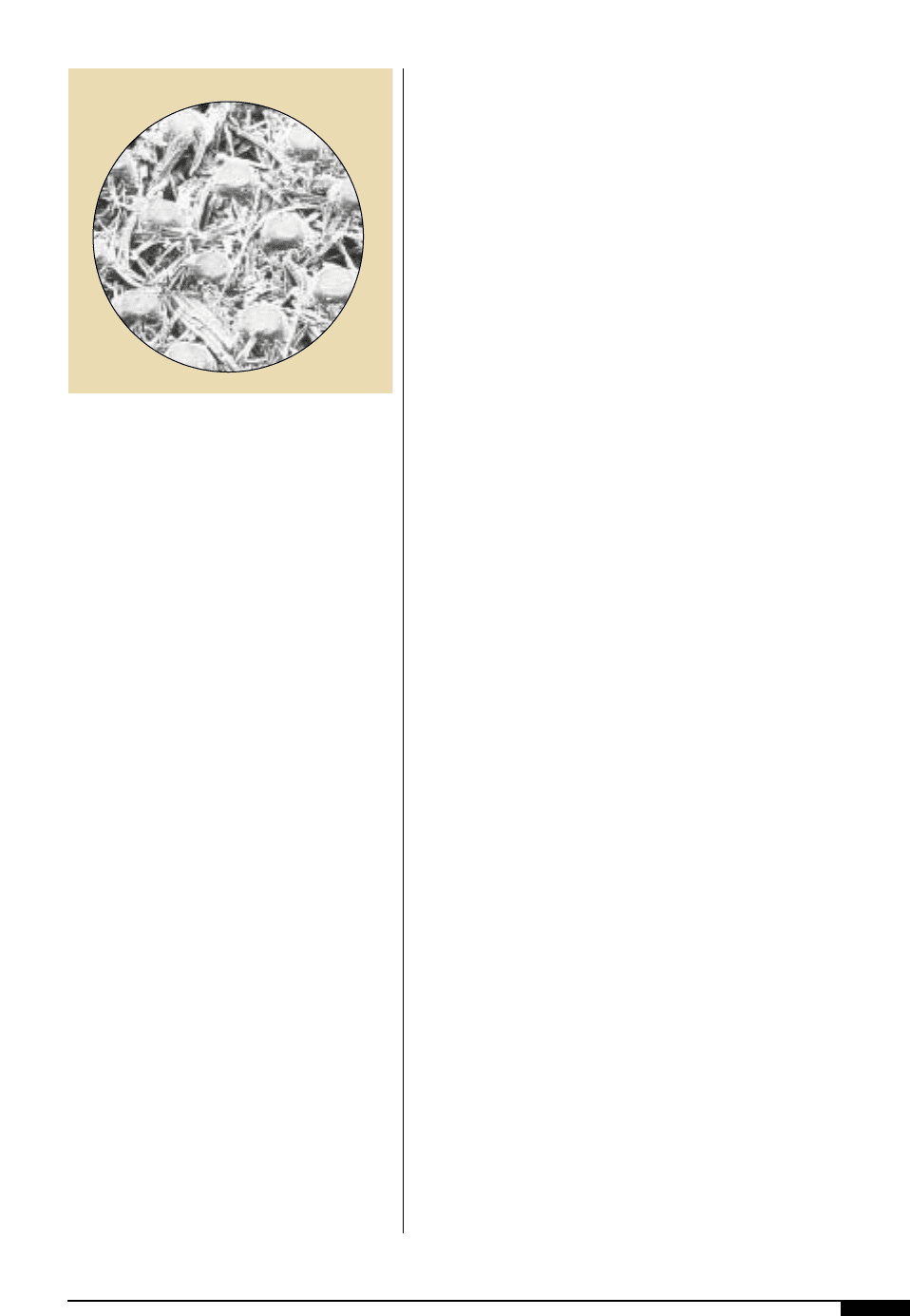
have adequate humidity control for proper
performance of papers. Different grades of
paper have different points of equilibrium
where fibers neither give up, nor take on,
moisture. Dry substrates may be more sus-
ceptible to press web breaks because many
flexographic presses pull the web through
the press rather than drive it through the
many nip points. Excessive moisture will
cause welts and wavy edges making further
converting difficult (Figure
8*
).
pH. The measure of whether a paper is alka-
line or acid is expressed as pH. The pH value
determines the paper’s permanence. Acid
papers with values lower than pH 7 have the
shortest life, while papers with pH values
greater than 7 have maximum longevity.
Sizing.Sizing refers to one or more chemicals
added during papermaking to improve the
substrate's end-use performance. There are
two types of sizing: internal and surface.
Internal sizing is mixed in the pulp at the wet
end of the paper machine. Surface sizing
involves applying a very light continuous film
of starch or other materials to one or both
sides of the web with a size press which is
usually located about two-thirds of the way
down the dryer section of the paper machine.
Benefits of sizing include an increase in the
ability of cellulose fibers to bond to each
other, which reduces the potential for internal
delamination and surface linting. Sizing also
increases the resistance of paper to absorbing
liquids such as water, ink, grease or blood. It
improves ink holdout by slowing the rate of
ink absorption into the fiber structure which
otherwise might contribute to unwanted
wicking, feathering, chalking and print densi-
ty loss. Surface smoothness, surface strength,
Mullen burst strength, tensile strength and
stiffness are enhanced by surface sizing.
Figure
8(
shows a plate plugged with fibers
which were poorly bound to the paper.
Wet Strength. Wet strength is important for
any paper that will be exposed to outdoor
weather conditions. Wet strength is obtained
by the addition of resins in the papermaking
furnish that increases fiber bonding.
Graphics. Conversion to a paper substrate
offers the important advantage of superior
graphic capabilities. The finish of the paper
can be altered to meet the customer need. A
printer is not limited to the use of kraft but
can obtain semibleached or full-bleached
kraft for improved graphic appearance.
Printing on these papers requires following
recommendations similar to those for plain
or coated papers.
Alkaline/Acid Paper
Paper is classified as acid or alkaline
depending upon the papermaking process
used. The pH of the paper identifies this dif-
ference. The factor pH is measured on a scale
of 1 to 14 with values less than 7 indicating
greater acidity and above 7 greater alkalinity.
Paper is traditionally manufactured on the
acidic side (pH 4.0–5.5) because of the rosin
sizing and alum that are used as fixing agents
to waterproof the paper. Clay is the filler com-
monly used for acid paper, and while it
improves opacity it is not very bright.
Titanium dioxide (TiO
2
) is added to improve
brightness. The use of clay has to be carefully
controlled because excess clay can weaken
the sheet. Titanium dioxide is expensive and
abrasive. It also must be controlled because it
SUBSTRATES 133
8(
A plate plugged with
fibers poorly bound to
the paper.
8(
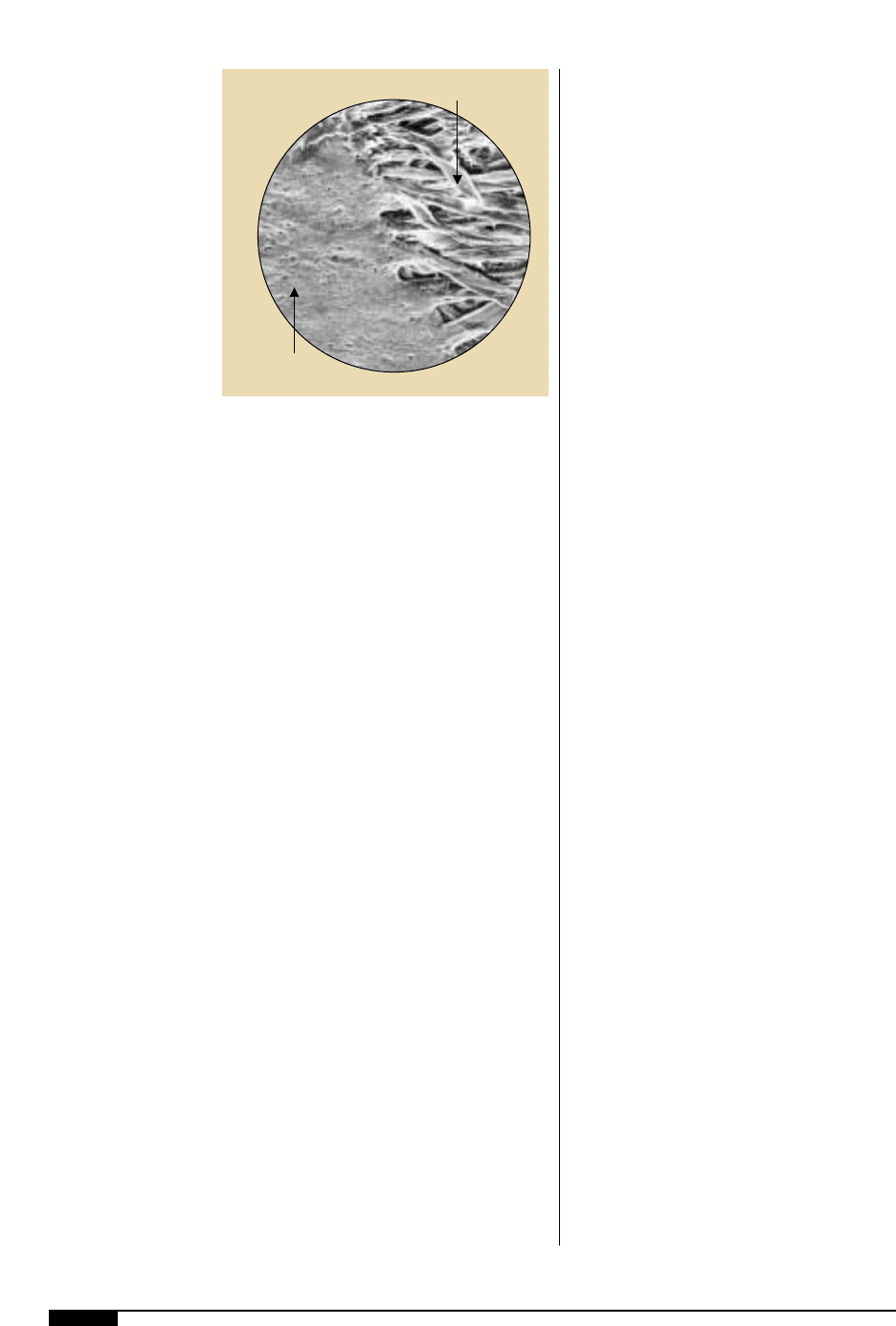
134 FLEXOGRAPHY: PRINCIPLES & PRACTICES
can dull slitter knives more quickly in con-
verting operations. Acid papers can eventual-
ly yellow and become brittle due to small
amounts of residual acid attacking the fibers.
Alkaline papers are manufactured in the pH
range of 7 to 8. This is considered essentially
neutral. The seemingly small difference
between the pH values are deceptive because
the scale is logarithmic, meaning each incre-
ment is 10 times greater than the last. Calcium
carbonate is the primary filler for alkaline
paper and this improves the appearance and
brightness without the addition of titanium
dioxide. Calcium carbonate can be abrasive in
its natural form, but paper makers use a chem-
ically manufactured precipitated form (PCC)
of the material. The advantages of alkaline
paper include higher natural brightness,
which gives greater printed ink contrast;
improved bulk, for better handling; greater
stiffness to enhance runability; and improved
archival qualities. The United States Govern-
ment has required that all its documents must
be printed on alkaline paper.
Acid and alkaline papers print equally well
by flexography.
Coated Papers
A large portion of papers printed by flexo,
such as label stock, some liner board and gift
wrap, are coated (Figure
9)
). The primary
reasons to coat a paper are to enhance the
appearance and to improve the printing sur-
face. Coatings also provide functional quali-
ties such as water resistance, grease proof-
ing and heat sealability. The paper acts as a
base for the coating., which improves the
surface of the paper by filling in the inherent
micro spaces created by the fibers overlay-
ing each other. It also improves the print for-
mation by making the flocs (hills or dark
areas of densified fiber) and voids (valleys,
areas with less fiber) produced during the
manufacture of paper less apparent. A more
uniform surface gives more consistent print
density, gloss and print smoothness. Coat-
ings must allow the escape of water-vapor
during printing, especially with heavy ink
coverage. The higher a basis weight and
coating thickness the greater the risk of the
paper blistering when drying, especially at
web temperatures above 212° F.
The coating is generally applied on the
paper machine after the size press. Sizing
helps hold the coating on the surface of the
fibers. Coatings are comprised of pigments
(clay or calcium carbonate), a binder (starch
or latex), flow modifiers (carboxyl methyl
cellulose), brighteners and whiteners.
Coated paper is then super-calendered either
on- or off-machine to give the final degree of
surface finish. A super-calender is a stack of
rolls that are a combination of alternating
hard cotton rolls and steel rolls which polish
the surface of the sheet. The number of nips
through which the paper passes determines
the final gloss, smoothness and caliper.
Coatings can be produced in a number of fin-
ishes from matte to enamel. Paper finish will
determine the final ink absorbency, gloss and
drying rate. The color of the coating will
determine the amount of “snap” or contrast
between the ink and the paper surface.
Problems encountered with coated papers
can take a number of forms. A mottled
appearance in the unprinted coating may
produce a mottled print. Imperfections in
9)
A magnified view of the
fiber structure in coated
and uncoated paper.
Uncoated
Coated
9)
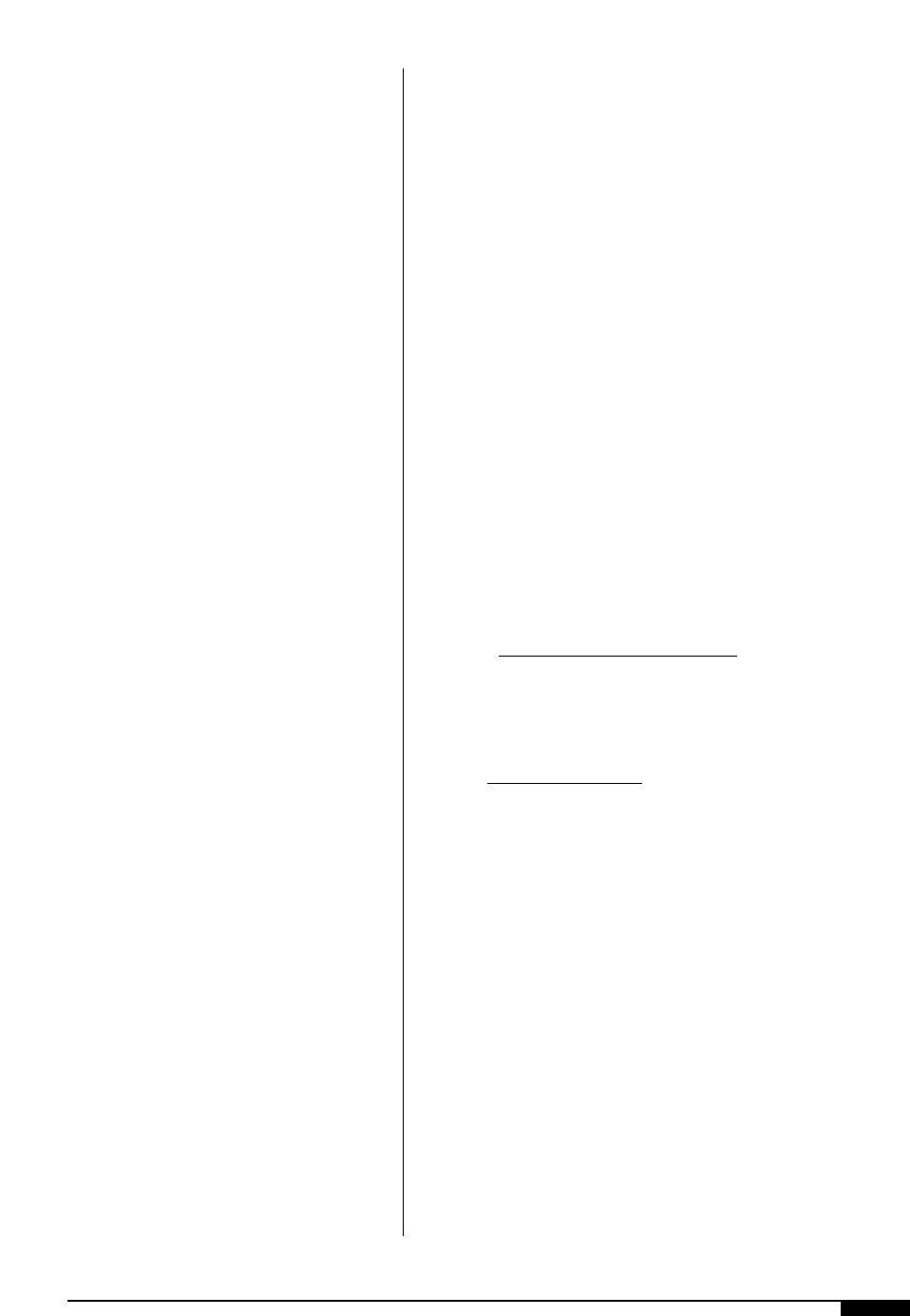
the coating surface such as pits, scratches
and streaks will negatively affect the fin-
ished print, especially in full ink-coverage
areas where voids will be noticeable but will
also negatively affect process work. Lower
gloss finishes can produce wet-ink rub
issues. The printing of high gloss papers
needs care in the selection of ink due to dry-
ing and ink- trapping issues resulting from
the higher ink holdout. Excess ink moisture
and some solvent-based inks can soften the
coating binders, so care should be taken to
match the paper and ink to the job and end-
use requirements.
Roll Quality
Most paper printed by the flexographic
method is in rolls, but some paperboard and
corrugated grades are printed as sheets.
While all of the previously discussed paper
properties are applicable to rolls, the quality
or construction of the roll is an additional
important issue. Due to advances in on-line
paper machine technology, variations in
basis weight and caliper are rare.
Paper immediately off the paper machine
is referred to as a log. The log is slit down to
the proper size for the end-use customer.
Rewinding and slitting of the rolls into the
ordered size can result in a number of prob-
lems, especially if the slitters are worn or the
rewind is not at the proper tension. Poor roll
quality can adversely affect converting pro-
ductivity.
Rolls should have uniform tension across
the grain, face or outer surface. Poorly
wound rolls will result in bounce and ten-
sion disturbances that can affect print regis-
ter. This bounce can also result in uneven
unwind and can cause the web to break.
Poor splicing may result in web breaks.
Cracked or damaged edges on a roll may
result in web breaks. Creases and wrinkles
may result from baggy rolls. Linting can
result from dull slitter knives and cause dirty
print due to fibers being liberated and accu-
mulating on the plate and in the ink.
If the roll is not smooth, or appears to be
ragged on the edges, it can be checked by
running a dark cloth over the edge. If an
accumulation of white debris is evident, it is
advisable not to use the roll. The printer/con-
verter should always save the roll identifica-
tion label to report roll condition to the man-
ufacturer.
Determining the amount of paper needed
for a specific job or number of labels has
become easier. Most manufacturers now list
the linear footage for each roll, but some-
times this information may be missing. Basis
weight affects the size of the roll and linear
footage. Lower basis weight paper will have
more linear footage than a heavier weight
paper.
The formula to determine the number of
feet in a roll is as follows:
WEIGHT
LINEAR
OF ROLL
BASIC SIZE
41.667
FEET (LBS) (LW)
WIDTH OF ROLL BASIS WEIGHT
(IN)
Example: Book paper basis size is 25" x 38",
55#, 40" wide, 2,000 lb. roll
LINEAR
2,000 25 38 41.667 35,985 feet
FEET
40 55
Basis weight may vary up to 5% above or
below the advertised weight for that particular
grade. If the actual basis weight is higher, the
footage will be slightly under; if the actual
basis weight is lower, then more footage will
be available. Most rolls are not run to the very
end due to problems with roll-set curl, so a
minimal thickness of paper is usually left on
the butt roll when splicing to a full roll.
PAPER AND ROLL
STORAGE/HANDLING
Paper is shipped in a moisture-proof wrap-
ping to maintain its production target mois-
ture. Cold paper should be brought into the
SUBSTRATES 135
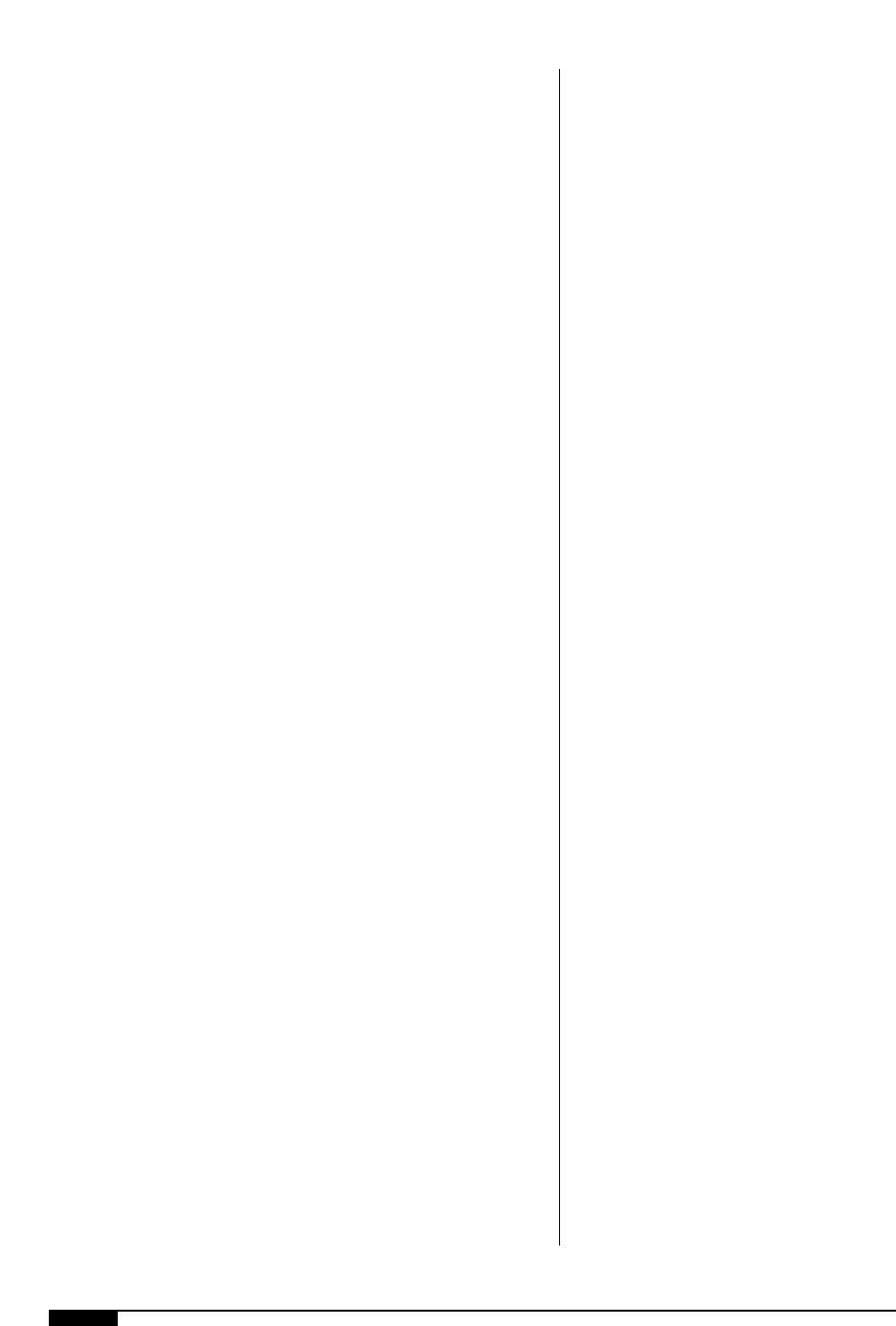
136 FLEXOGRAPHY: PRINCIPLES & PRACTICES
pressroom and sufficient time allowed for
the roll to come to the same temperature as
the environment. Pressroom humidity is
important when printing paper. Paper per-
forms best when the relative humidity is less
than 8% drier or wetter than that of the
paper. Paper is hygroscopic, meaning it will
absorb or lose moisture. Once the paper has
picked up or lost moisture it is impossible to
change back to the original manufactured
moisture content. Some performance char-
acteristics of the paper will be lost by the
change in moisture. To avoid problems with
dimensional stability, curl, register problems
and dot gain, it is advisable not to unwrap a
roll of paper until ready to put it on press. A
partially used roll should always be wrapped
again to avoid changes in the paper proper-
ties. Paperboard behaves in the same man-
ner. The degree of moisture change in paper-
board is dependent on fiber type, condition
of fiber (degree of recycle) and structure.
Rolls should be handled carefully. Dropping
a roll can crush the cores, making it difficult to
put on the press shaft. Damaged cores can
also result in tension variation that translates
into print misregister, repeat-length abnormal-
ities and slower press production. Bumping a
roll with a fork-lift can damage many layers of
paper in the roll, making it unusable. Rolls
should always be moved with a clamp truck.
PAPER FINISHES
There are basically two types of paper fin-
ishes, uncoated and coated. Uncoated papers
can vary greatly in appearance from a very
smooth and shiny surface to an antique finish
that has a rough, distinctive texture. In con-
trast, coated papers have a smooth finish and
are classified by their gloss or shininess.
Uncoated Paper Finishes
Antique, Eggshell and Vellum. Refers to
uncoated papers with a rough, distinct sur-
face texture. Antique is the roughest, fol-
lowed by eggshell with a pitted texture and
vellum as the smoothest.
Machine and English. Differs from the antique
finishes by having a smoother, more pol-
ished surface.
Felt. Made by having the felt mark trans-
ferred to the paper and is partly dried to imi-
tate handmade paper.
Laid. Paper which has a fine crisscross of
vertical and horizontal lines.
Embossed. This finish is applied after the
paper is off the machine. These papers are
made by passing the paper through two rolls
that stamp a three-dimensional pattern into
the paper.
Supercalendered. This paper is characterized
by a smooth and shiny finish.
Coated Paper Finishes
Enamel Coated. The highest or heaviest coat-
ed paper which is highly supercalendered,
generally to a 75° gloss of 60% or higher.
Dull Coated. This paper is lightly supercalen-
dered to have a low gloss (typically 30% to
40% at 75°) and is very good for readability.
Matte Coated. A fully coated, nonsupercalen-
dered finish that has virtually no gloss
(below 25% at 75°), but tends to be more
prone to poor ink-rub resistance, due to the
large rough-surfaced pigments used to scat-
ter light and reduce gloss.
Embossed Coated. This paper is coated, then
embossed with a three-dimensional pattern,
producing a textured surface having a slight-
ly lower gloss.
Cast Coated. Paper which has its pigmented
coating dried, while held against a highly
polished surface similar to a glossy photo-
graph. Cast-coated papers are usually mea-
sured with a 20° glossmeter rather than an
75° instrument normally used to character-
ize other pigmented-coated papers.
Coated One Side (C1S). Widely used for
labels, the uncoated side is compatible with
adhesives.
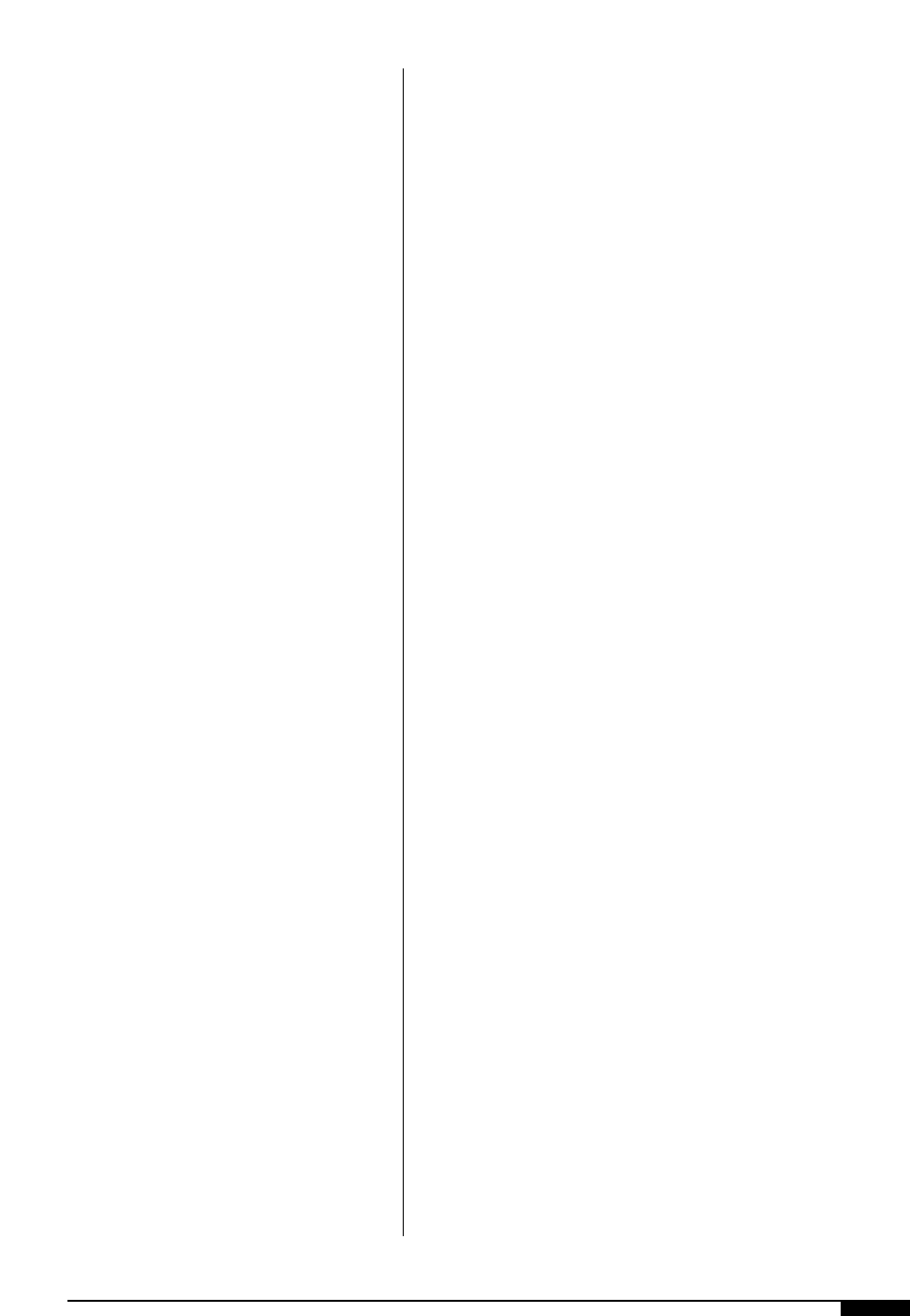
PAPERBOARD
There is no strict definition distinguishing
paperboard from paper. Paperboard is sim-
ply referred to as board and is a major raw
material in packaging. It is distinguished
from paper by physical properties like stiff-
ness and thickness. Since the structure con-
sists of cellulose fibers, it has the same
strength-to-weight ratio as paper. Board
includes boxboard, chipboard, container
board and solid fiber. It can be used for fold-
ing cartons, containers for liquids, or con-
verted into drums for transportation of bulk
chemicals. The structure of paperboard is
determined by its end use. Structure can be
single-ply or two to eight thinner plies.
Multiple plies allow for the use of different
types of fibers in each ply. Bonding of the
fibers between the plies is extremely impor-
tant because deterioration in strength during
processing is undesirable. The combination
of ingredients produces a paper product that
is strong enough to protect heavy or large
materials during shipping.
The main difference between paper and
paperboard is caliper. Generally, substrates
with a thickness of 0.012" (12 points or 305 mi-
crons) or more are paperboards; thinner
structures are considered paper. Other differ-
ences are in the description of the compo-
nents that make up the board. An example is
the top side of the board. It is called the felt
side for paper, but is often referred to as the
liner side in board. The liner is usually a ply or
layer of good quality fiber applied to the top
side, which ultimately will be printed. The
underliner is the layer in between the two
external layers. Triplex boards consist of
three different types of fiber plies. Multiplex
boards have more than three layers.
Paperboard, due to its higher thickness, has
greater stiffness. When converting paper-
board, scoring is sometimes necessary to
avoid cracking or breaking the internal struc-
ture of the sheet. A flexographer must consid-
er the side of the board to be printed since the
finish, whether coated or uncoated, will affect
ink drying and printed color.
Paperboard is usually opaque due to its
greater thickness. To obtain good printing
characteristics, paperboard will have a
bleached chemical pulp for the liner. This also
improves the appearance of the final product.
Darker plies are usually used for the interior.
Printing and Handling
Like paper, paperboard is surface-sized or
pigment-coated for good printability. Like
paper, paperboard will absorb moisture and
change its dimensions. The degree of change
depends on the fibrous structure. Paper-
board will often be glued and so the surface
structure must be absorbent. Often the liner
side of the board will be printed and the back
side glued. Some grades of paperboard are
known as double-lined; in this case the two
faces of the web are both of high quality.
Types of Board
Can Board. A paperboard used for composite
fiber drums. The cans can be used for a vari-
ety of liquids and powders.
Carton Board. A paperboard of various com-
positions used for the manufacture of fold-
ing cartons.
Chip Board. A board made from waste paper,
and used for low-grade packaging and book
board.
Coated Board. Paperboards of various grades
that have a coating for high quality graphics.
Cup/Plate Stock. High stiffness paperboard
containing one or more plies of virgin
bleached pulp suitable for converting to
paper cups or plates. The stock may be poly-
ethylene coated before flexo printing or wax
coated after printing.
Double-lined Board. A board which is lined on
both sides; the outer surfaces are lined with
bleached pulp. Used for high quality packag-
ing of food and cosmetics.
Fluting Medium. A board made from semi-
chemical hardwood pulp or waste paper that
SUBSTRATES 137
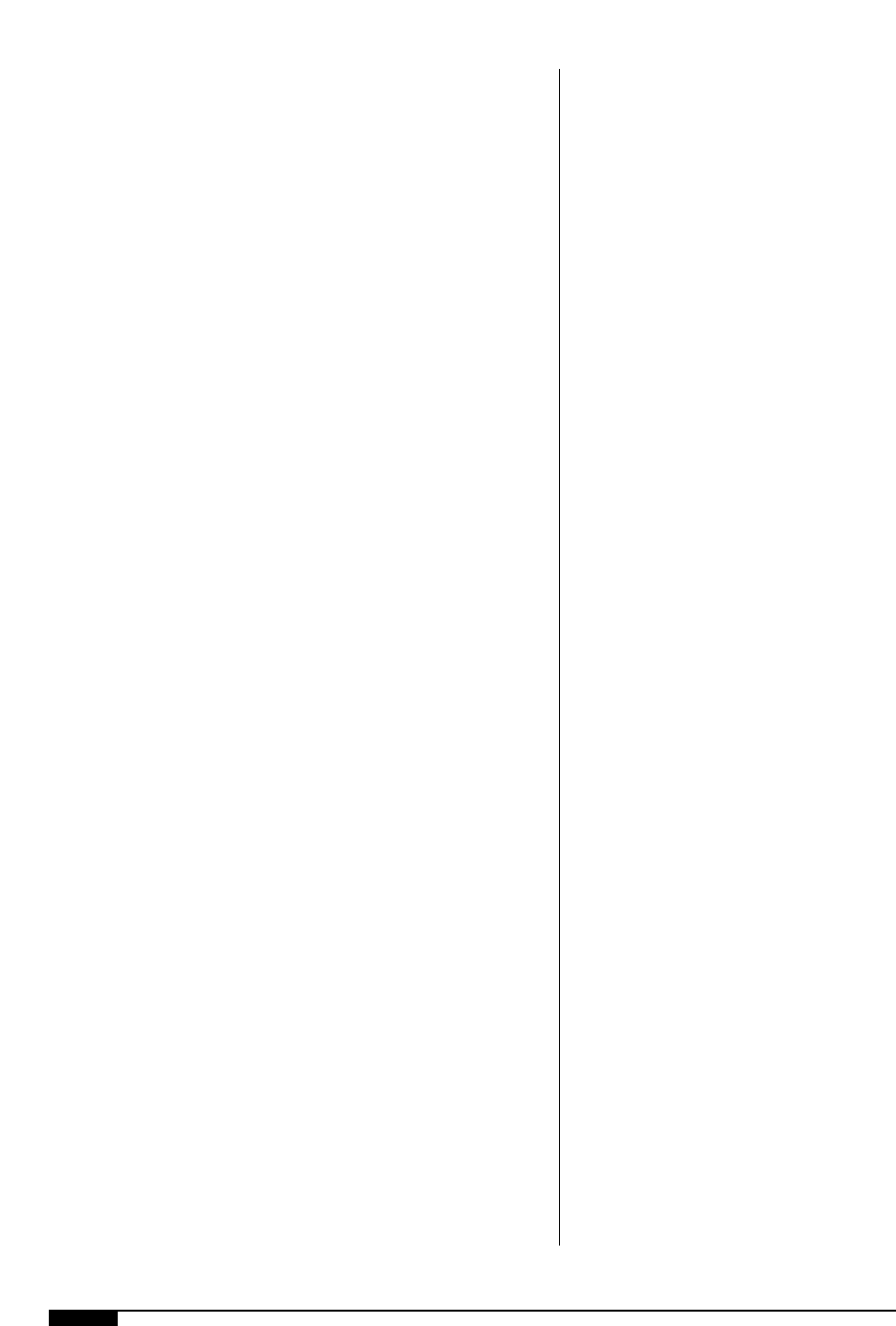
138 FLEXOGRAPHY: PRINCIPLES & PRACTICES
is fluted and combined with liner board to
produce corrugated board.
Food Board. A hardsized board for water
resistance. Used for food packaging.
Frozen-food Board. Single- or multi-ply board
with resistance to high moisture and water
vapor. This usually is a coated board for high
quality graphics.
Kraft-lined Chipboard. A board with an
unbleached kraft liner on a wastepaper base.
Kraft Linerboard. A strong packaging paper-
board with two-ply construction made from
virgin kraft pulp. The top ply is added by a
second headbox. Used in combination with
a fluted medium for corrugated boxes.
Lined Board. A multi-ply board with a liner ply.
Liquid Packaging Board. Also called milk-car-
ton board, this strong board is usually plastic
coated.
Solid Bleached Sulfate. High quality board
usually made with 100% bleached kraft pulp
and coated on one or both sides to enhance
process color printing.
Solid Unbleached Sulfate. Unbleached chemi-
cal pulp provides an exceptionally strong
board with very good tear and burst resis-
tance; frequently coated white on one side
for printing.
White-lined Board. A board with bleached
pulp liner and the remainder composed of a
mixture of chemical and mechanical pulp.
Used for food packaging.
LABEL STOCK
Label stock is very diverse and can include
paper, laminates, metallic foils, plastic and
synthetic substrates. It can be divided into
groups like coated and uncoated, pressure
sensitive or heat sensitive, gummed or self-
adhesive. Plain paper labels are used exten-
sively but generally are coated on the printing
side so an adhesive can be applied to the back
side of the paper. This type of label is used for
large-volume items like soft drinks, wines and
canned foods. These papers have a tendency
to curl when printed. It is advisable to wet the
back or uncoated side during printing, if an
adhesive has not been applied, to help elimi-
nate the curl tendency.
MULTIWALL BAGS
The first U.S. patent for paper-sack making
machines was granted in the 1860s, when,
due to the Civil War, paper replaced the dif-
ficult-to-obtain cotton sacks. Multiwall bags
replaced the use of cotton sacks to ship flour
and grains to distant cities. Further expan-
sion of this type of shipping method was
fueled by the shortages created by World
War II. During this time the use of the multi-
wall bag came into wide usage. The develop-
ment of a wide range of special papers to
control moisture and insect infestation, plus
the ability to tailor-make the shipping con-
tainer to any required strength to fit difficult
handling, gave a big boost to this industry.
The major advantages of paper-shipping
sacks are low tare weight, flexibility, ease of
filling and handling, low cost, minimum stor-
age, biodegradability and good graphics.
ENVELOPE PAPER
Envelopes are made from many paper
grades, depending on end use and printing
requirements. The grades can vary from
bleached to unbleached kraft, to fine paper,
to some label stocks. In some cases, synthet-
ic paper is used for heavy shipping require-
ments. The ink must be specified for the type
of paper. Most envelopes are printed in-line
by the flexographic method, although a por-
tion are still printed by sheetfed offset and
later die cut into blanks. In some cases, the
blanks are cut, then flexo-printed and folded.
Papers used for envelopes must have good
dimensional stability, bulk and stiffness to
allow for manufacture at high speed with
good printability. Paper moisture is critical
when heavy ink coverage is used because
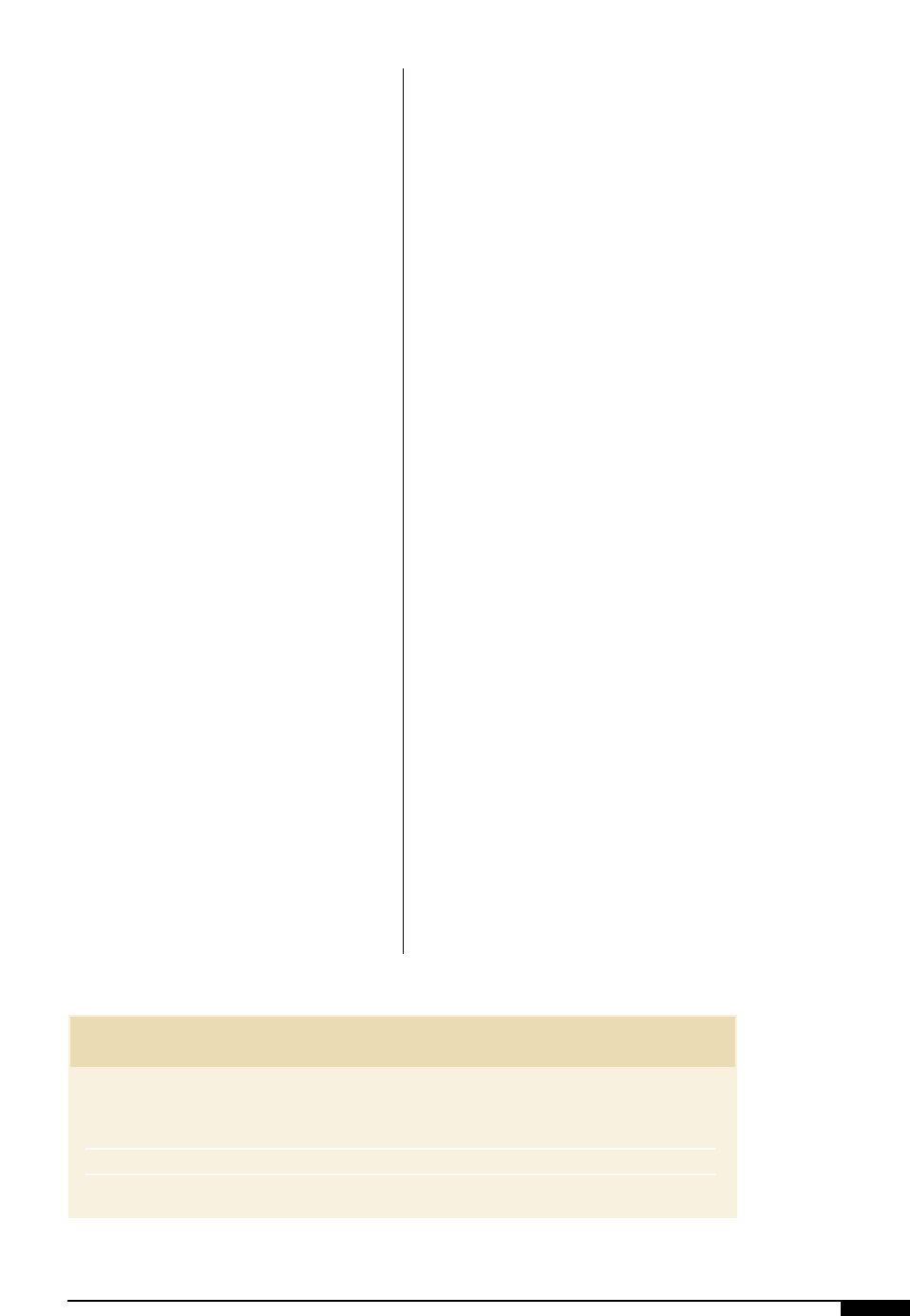
excess moisture will cause the die cutting to
become ragged and the sheet to lose stiff-
ness. Formation is important when printing
halftones because the higher the line screen
used for the art work, the more the nonuni-
formity of the paper formation will be
enhanced.
GLASSINE PAPER
The primary use of glassine paper is in the
flexible packaging and specialty applica-
tions. It is highly dense and resistant to the
passage of oil, grease and air. These proper-
ties are developed through a damp supercal-
endering process which produces a dense,
smooth, glossy paper. The glassine sheet is
an ideal substrate for heat-seal materials and
barrier coatings. Polyvinylidene chloride,
polyethylene, silicone, hot melts and waxes
all have been applied successfully to glas-
sine paper. Glassine paper can be modified
to accept almost any ink on virtually any
press. It has been used in envelopes, candy
wrappers, liners for cereal and cracker
boxes, potato chip bags, pie bags, medical
packaging, safety jar seals, pouches, soap
wrappers and photographics. Glassine can
be modified for virtually any printing or
strength requirements.
Physical Properties
Originally, glassine paper was highly trans-
parent (low opacity), but exhibited low
paper strength. Today glassine covers a wide
range of levels in strength, color and opacity.
Typically, softwood pulps of the kraft and sul-
fite process constitute the raw material.
Depending on color requirements, the fiber
may be bleached, unbleached or semi-
bleached. Bleached hardwood krafts have
been used, but only in small quantities
because of adverse strength and refining
properties.
Abrasion while in suspension during refin-
ing is used to increase the fibers' surface area.
Hydroxyl groups are exposed on the fiber sur-
face to provide sites for hydrogen bonding.
Natural grease and air resistance is indicative
of the amount of fiber contact developed in
refining. Damp supercalendering makes the
sheet denser to increase gloss and boost resis-
tance to grease and air passage.
Glassine paper contains no fillers and is
translucent (low opacity). These grades can
be made at varying levels of opacity, depend-
ing on weight and end use. Various pouches,
envelopes and bags are currently being
printed on this unfilled or bleached glassine.
In pigment-filled glassine paper, a filler (an
inert pigment such as titanium dioxide) is
added to block the flow of light through the
sheet. Opacity is highly desirable for candy
bar wrappers and potato chip bags to filter
out ultraviolet light. Opaque glassine paper
varies in weight, grease and air resistance,
opacity, gloss and application requirements.
Table 21 summarizes some of the physical
properties of glassine paper.
SUBSTRATES 139
Table 21
GLASSINE BASIS WEIGHT GLOSS OPACITY TEAR SMOOTHNESS
(#/3000 FT
2
) (%) (%) (G) (ML/MIN)
Lt. Choc. Glassine 25 35–45 70–80 18–22 under 125
Candy Bar Wrap 25 45–55 55–70 18–22 under 125
Bleached Glassine 25 35–55 20–30 16–20 under 125
PHYSICAL PROPERTIES OF GLASSINE
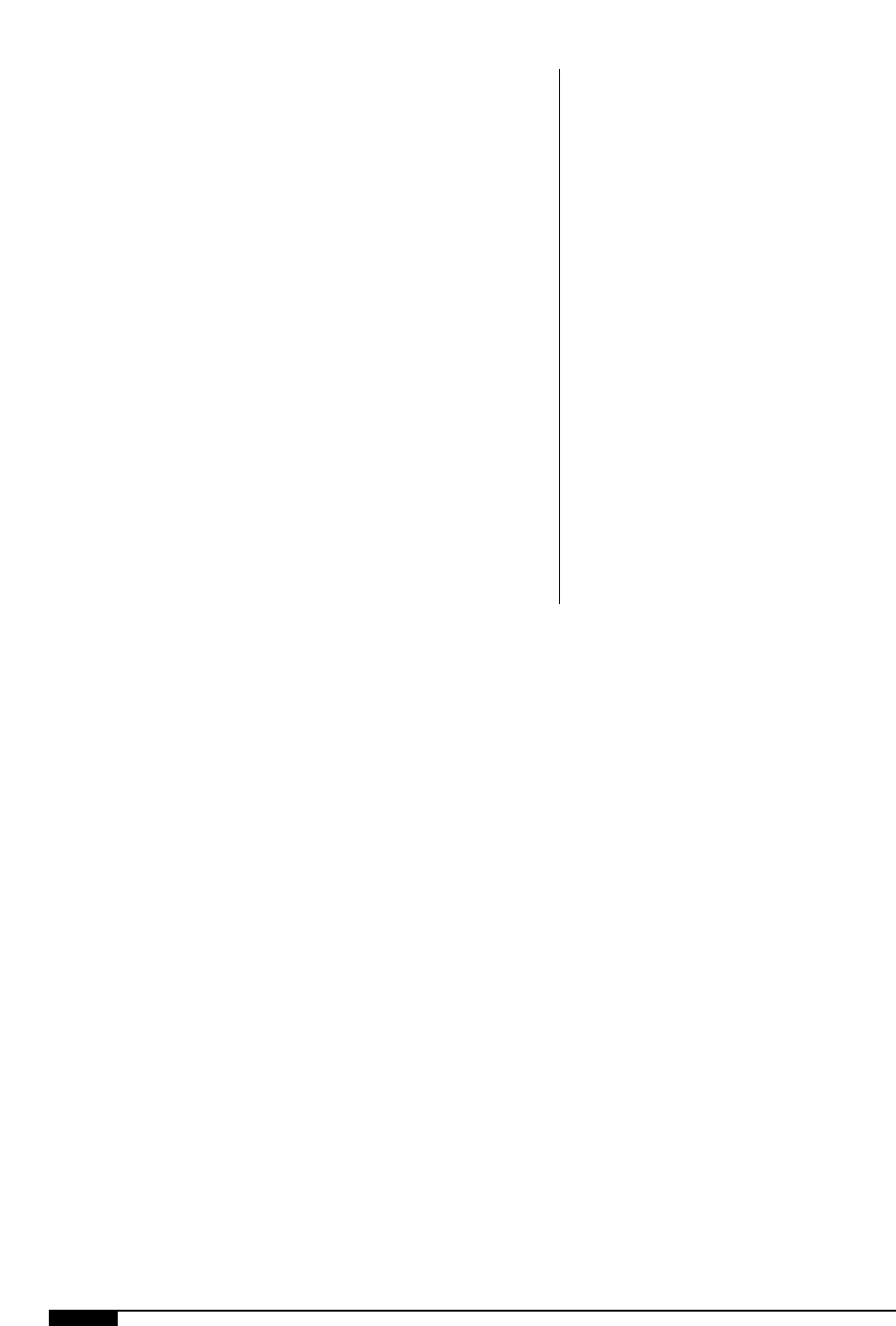
140 FLEXOGRAPHY: PRINCIPLES & PRACTICES
Printing and Handling
Characteristics
Glassine paper is handled differently from
other substrates, mainly because the fibers of
the highly refined sheets are very reactive to
moisture. Many printers and converters use
water-based inks and coatings because of the
volatile organic compound (VOC) regula-
tions. However, improvements in wet-end
chemistry, refining and surface treatment has
produced glassine paper of greater dimen-
sional stability, so it is possible to obtain glas-
sine paper that will do just as well as other
substrates using solvent-based inks.
When converting glassine, the paper
should not be allowed to lose any more than
a minimum of its original moisture. Loss of
moisture can cause brittleness and weaken
web strength. As the paper loses moisture
below the supplied content, a small amount
of shrinkage should be expected.
TISSUE
Tissues are a special category of sub-
strates which run the gamut from semitrans-
parent to totally opaque. They may be made
very weak and soft or surprisingly strong
and hard. Tissue is almost always character-
istically fairly thin, unless combined in mul-
tiple plies by embossing or adhesives.
Tissue-making paper machines are among
the fastest in the industry with production
speeds up to 5,000 ft/min. Tissue formed on
a Fourdrinier wire is further dried in a press
section and against a huge (typically about
18' in diameter) heated Yankee drum. Paper
towels and napkins are among tissue com-
monly printed by flexography using water-
based ink. Producing tissue with fiber
strength to resist linting during printing and
maintain fluffy softness desired in the end
product is a technical balancing act for the
papermaker.
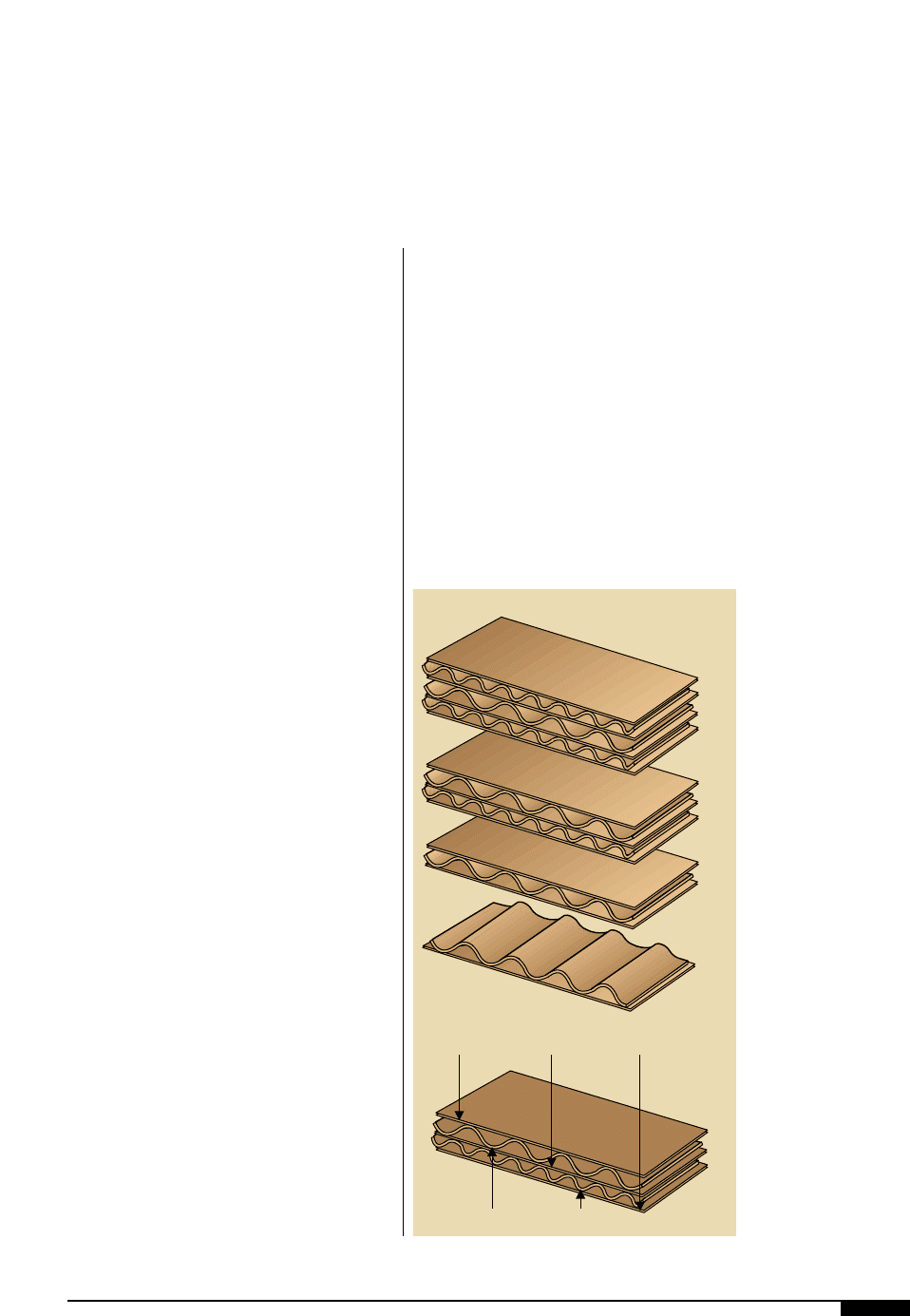
SUBSTRATES 141
Corrugated Board
9!
The different types of
corrugated board and its
construction.
C
orrugated packaging is the most
popular and cost-effective pack-
aging method for the transporta-
tion of manufactured goods
today. Corrugated board’s main
purpose is to protect its con-
tents by cushioning. It’s very high strength-to-
weight ratio allows this material to be strong
despite its light weight.
BOARD CONSTRUCTION
Corrugated material is a composite made
from paperboard components of the liner,
which is the outside face, and the medium,
which is the internal fluted structure that
gives the board its strength There are differ-
ent types of board construction as shown in
Figure
9!
.
The Medium
The medium is generally made up of short-
er fibers and is more flexible than the liner. It
is usually made of hardwood fibers from
deciduous trees and is made by the sulfite
process. Resin is added to the pulp to
improve wet strength. It also has a lot of
stretch to it, allowing the paperboard to be
fluted without cracking. Flutes are the char-
acteristic that give the combined board its
rigidity and strength with low weight and den-
sity. The fluting provides the stiffness and the
resistance to crushing in the corrugated box.
Looking at the magnified view of the medi-
um in Figure
9@
, it can be seen that there are
a lot of spaces or voids in the fiber construc-
tion of the medium. These void areas receive
the adhesive and serve as the anchor point for
the bond between the liner and the medium.
Because the medium is normally sandwiched
between two layers of liner, there is no real
concern for sheet appearance
The Liner
The outside face is made of natural kraft.
This kraft paper is made primarily of soft-
wood from coniferous (evergreen or pine)
trees. The pulp is made by the sulfate
process from wood chips. The kraft fiber
can be bleached to lighten dark components.
Triple
Wall
Double
Wall
Double
Face
Single
Face
Inside Liner
Outside Liner
Medium
Center Liner
Medium
9!

142 FLEXOGRAPHY: PRINCIPLES & PRACTICES
After washing and refining, the paper is
made on a specialized Fourdrinier machine.
The difference between this machine and
normal paper machines is the use of two
headboxes. About 80% of the fiber first
deposited on the wire is less refined and
stronger. The remaining fiber is more refined
and smoother and is applied to the felt (top
or finished) side of the sheet.
Two types of finishes are possible, wet fin-
ish or dry finish. The wet finish has a coating
of starch applied before the calender and is
smoother than the dry finish, which is uncal-
endered.
Mottled white liner board is made by the
same method but has both kraft and
bleached kraft in its composition. The top
layer of bleached kraft is not enough to
make a perfectly white layer but is sufficient
to give an improved imaging surface for
packaging applications, thus the mottled
appearance and name.
Combined Board Construction
At the corrugator, the roll stocks of both
medium and liner are converted into com-
bined corrugated board and cut into sheets,
which are also known as blanks. Corrugated
board is manufactured in a number of con-
structions (see Figure
9!
). The simplest form,
known as single-face, is used for wrapping
fragile items, but not for making shipping con-
tainers. Double-face is the most common con-
struction and uses a fluted medium sand-
wiched between two layers of liner. The dou-
ble-wall and triple-wall configurations provide
9@
A magnified view of the
medium shows voids in
the fiber construction.
These void areas receive
the adhesive and serve
as the anchor point for
the bond between the
liner and the medium.
Blown-up View
of Medium
Blown-up View
of Liner
Roll of
Medium
Roll of
Liner
Roll of
Liner
Corrugated
Medium
Medium:
Liner:
Paperboard used to line or face corrugated
core board (on both sides) to form shipping boxes.
• Additional refining
• Smooth surface for printing
Bottom Liner
Top Liner
Blank
Fluted Medium
Light-weight board used for the fluted
inner ply of corrugated box stock.
• Stiffness
• Resistance to crushing
• High stretch
• Gaps provide holding volume for adhesive
9@
